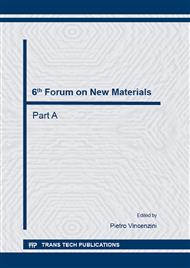[1]
Song, C.S., Global challenges and strategies for control, conversion and utilization of CO2 for sustainable development involving energy, catalysis, adsorption and chemical processing. Catalysis Today, 2006. 115(1-4): pp.2-32.
DOI: 10.1016/j.cattod.2006.02.029
Google Scholar
[2]
Specht, M., et al., Comparison of the renewable transportation fuels, liquid hydrogen and methanol, with gasoline-energetic and economic aspects. International Journal of Hydrogen Energy, 1998. 23(5): pp.387-396.
DOI: 10.1016/s0360-3199(97)00077-3
Google Scholar
[3]
Zhang, J., et al., Mixed-Metal Pt Monolayer Electrocatalysts for Enhanced Oxygen Reduction Kinetics. Journal of the American Chemical Society, 2005. 127(36): pp.12480-12481.
DOI: 10.1021/ja053695i
Google Scholar
[4]
Guo, S., S. Zhang, and S. Sun, Tuning Nanoparticle Catalysis for the Oxygen Reduction Reaction. Angewandte Chemie International Edition, 2013. 52(33): pp.8526-8544.
DOI: 10.1002/anie.201207186
Google Scholar
[5]
Cui, C., et al., Compositional segregation in shaped Pt alloy nanoparticles and their structural behaviour during electrocatalysis. Nature Materials, 2013. 12(8): pp.765-771.
DOI: 10.1038/nmat3668
Google Scholar
[6]
Godinez-Salomon, F., M. Hallen-Lopez, and O. Solorza-Feria, Enhanced electroactivity for the oxygen reduction on Ni@Pt core-shell nanocatalysts. International Journal of Hydrogen Energy, 2012. 37(19): pp.14902-14910.
DOI: 10.1016/j.ijhydene.2012.01.157
Google Scholar
[7]
Garsany, Y., et al., Experimental Methods for Quantifying the Activity of Platinum Electrocatalysts for the Oxygen Reduction Reaction. Analytical Chemistry, 2010. 82(15): pp.6321-6328.
DOI: 10.1021/ac100306c
Google Scholar
[8]
Kresse, G. and J. Hafner, Ab initio molecular dynamics of liquid metals. Physical Review B: Condensed Matter and Materials Physics, 1993. 47(1): pp.558-61.
DOI: 10.1103/physrevb.47.558
Google Scholar
[9]
Kresse, G. and J. Furthmueller, Efficient iterative schemes for ab initio total-energy calculations using a plane-wave basis set. Physical Review B: Condensed Matter, 1996. 54(16): pp.11169-11186.
DOI: 10.1103/physrevb.54.11169
Google Scholar
[10]
Perdew, J.P. and Y. Wang, Accurate and simple analytic representation of the electron-gas correlation energy. Physical Review B, 1992. 45(23): p.13244.
DOI: 10.1103/physrevb.45.13244
Google Scholar
[11]
Blochl, P.E., Projector Augmented-Wave Method. Phys. Rev. B, 1994. 50(24): pp.17953-17979.
DOI: 10.1103/physrevb.50.17953
Google Scholar
[12]
Kresse, G. and D. Joubert, From ultrasoft pseudopotentials to the projector augmented-wave method. Phys. Rev. B, 1999. 59(3): pp.1758-1775.
DOI: 10.1103/physrevb.59.1758
Google Scholar
[13]
Dudarev, S.L., et al., Electron-energy-loss spectra and the structural stability of nickel oxide: An LSDA+U study. Physical Review B, 1998. 57(3): pp.1505-1509.
DOI: 10.1103/physrevb.57.1505
Google Scholar
[14]
Heyd, J. and G.E. Scuseria, Efficient hybrid density functional calculations in solids: Assessment of the Heyd-Scuseria-Ernzerhof screened Coulomb hybrid functional. Journal of Chemical Physics, 2004. 121(3): pp.1187-1192.
DOI: 10.1063/1.1760074
Google Scholar
[15]
Heyd, J., G.E. Scuseria, and M. Ernzerhof, Hybrid functionals based on a screened Coulomb potential (vol 118, pg 8207, 2003). Journal of Chemical Physics, 2006. 124(21).
DOI: 10.1063/1.2204597
Google Scholar
[16]
Chen, S.L. and A. Kucernak, Electrocatalysis under conditions of high mass transport rate: Oxygen reduction on single submicrometer-sized Pt particles supported on carbon. Journal of Physical Chemistry B, 2004. 108(10): pp.3262-3276.
DOI: 10.1021/jp036831j
Google Scholar
[17]
Stamenkovic, V., et al., Changing the activity of electrocatalysts for oxygen reduction by tuning the surface electronic structure. Angewandte Chemie, International Edition, 2006. 45(18): pp.2897-2901.
DOI: 10.1002/anie.200504386
Google Scholar
[18]
Balbuena, P.B., et al., Evolution of Pt and Pt-Alloy Catalytic Surfaces Under Oxygen Reduction Reaction in Acid Medium. Topics in Catalysis, 2012. 55(5-6): pp.322-335.
DOI: 10.1007/s11244-012-9800-8
Google Scholar


